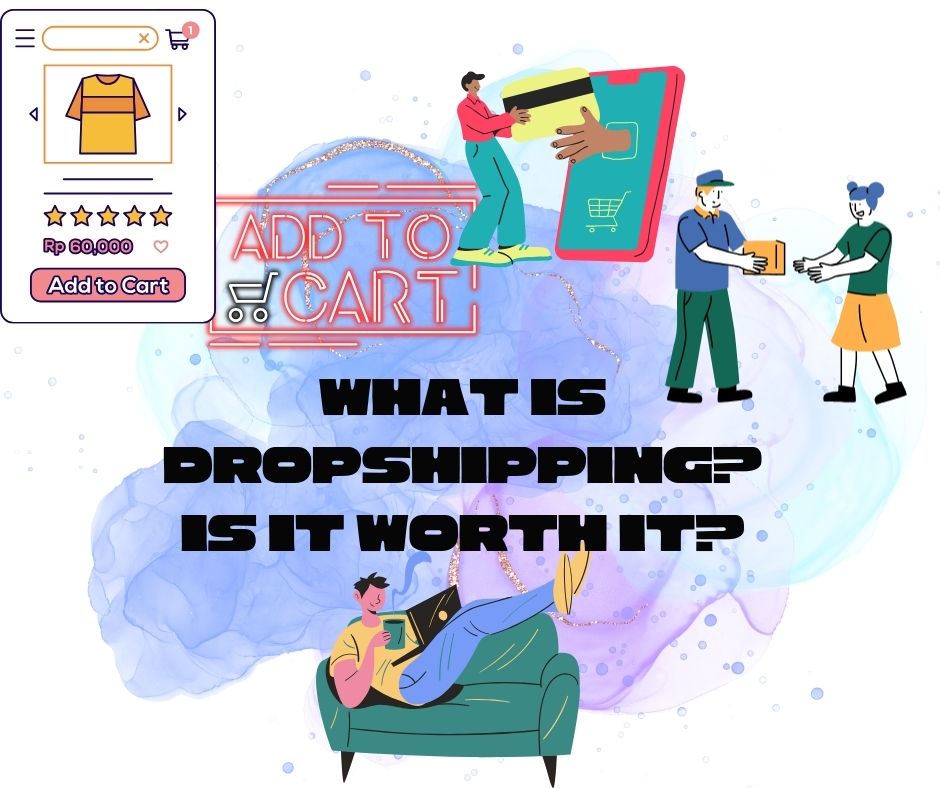Table of Contents
ToggleI. Introduction
A. What is dropshipping
Embarking upon the e-commerce journey, dropshipping stands out as a pivotal model, enabling entrepreneurs to dive into the retail space with minimized risk and maximized potential. Dropshipping, succinctly, is a retail fulfillment strategy where stores sell products without housing them in stock. When a sale is made, the order is forwarded to a third-party supplier who ships the product directly to the customer, eliminating the need for the retailer to manage inventory or handle shipping.
B. Brief Overview of its Popularity and Growth
The dropshipping model has witnessed a meteoric rise in popularity, particularly in the digital era where online shopping has become deeply ingrained in consumer behavior. The allure of starting a business without the need for substantial upfront investment in inventory has drawn many to explore the dropshipping realm. Furthermore, the ability to offer a wide array of products without the necessity of physical storage space has enabled retailers to explore and adapt to various market trends with agility and minimal financial risk.
C. Dropshipping Relevance in 2023
As we traverse through 2023, dropshipping continues to hold a significant position in the e-commerce landscape. The ongoing advancements in digital technology, coupled with the sustained growth of online shopping, have ensured that dropshipping remains a relevant and viable business model. Amidst the ever-evolving market trends, dropshipping provides a flexible platform for retailers to test and adapt to shifting consumer demands, explore various niches, and scale with relative ease. However, the question persists: Is dropshipping truly worth it, and how does one navigate its intricacies to carve out a successful venture? This guide seeks to unravel the layers of dropshipping, exploring its mechanics, advantages, and challenges, providing a comprehensive overview for those seeking to decipher its worth and potential in the contemporary retail space.
II. The Mechanics of Dropshipping
A. How Dropshipping Works
Navigating through the intricacies of e-commerce, dropshipping emerges as a model that simplifies the retail process, particularly in the digital domain. But how does this mechanism function, and what roles do merchants and suppliers play in this intricate dance of product sale and delivery? Merchants, or retailers, operate the storefront—virtual or physical—where customers make their purchases. However, unlike traditional retail models, merchants do not keep a stock of the products. Instead, when a sale is made, the order details are forwarded to a supplier. The supplier, in turn, ships the product directly to the customer, bypassing the merchant in the physical handling of the product. This symbiotic relationship allows merchants to focus on marketing and customer service, while suppliers manage inventory and fulfillment.
B. The Dropshipping Process Visualized
Visualizing the dropshipping process, imagine a seamless transition from customer order to product delivery, all orchestrated without the merchant ever physically interacting with the product. The customer places an order with the merchant, the merchant forwards the order to the supplier, and the supplier ensures the product reaches the customer. This streamlined process reduces overheads for the merchant and allows for a diverse product offering without the need for extensive storage space.
C. Popularity and Market Size
In the realm of e-commerce, dropshipping has carved out a substantial niche, particularly appealing to small businesses and startups due to its low initial investment and operational simplicity. The model has witnessed significant growth, especially in regions like the Asia Pacific, where e-commerce platforms have proliferated. Various statistics and forecasts predict a continued upward trajectory for dropshipping, especially as technological advancements continue to enhance the efficiency and accessibility of online retail.
III. Advantages of Dropshipping
A. Lean Operation
In the kaleidoscopic world of e-commerce, dropshipping has emerged as a beacon for entrepreneurs, offering a lean operational model that mitigates financial risks and reduces upfront investments. The absence of the necessity to manage inventory or handle shipping logistics allows businesses to operate with significantly lower overhead costs. This budget-friendly approach not only facilitates a quicker start but also enables entrepreneurs to venture into the retail domain without the burden of hefty initial expenditures or the challenges of managing physical stock.
B. Product Diversification
Dropshipping uniquely positions retailers to offer a diverse array of products without being tethered to inventory limitations. This flexibility allows businesses to adapt to shifting market trends, explore various niches, and test customer demand for different products without financial strain. Retailers can seamlessly alter, expand, or refine their product offerings in response to consumer preferences and market data, ensuring that the store remains relevant, competitive, and aligned with consumer desires.
C. Scalability
One of the stellar advantages of dropshipping is its inherent scalability. As the business grows, handling increased orders does not necessitate a proportional increase in operational efforts or resources from the retailer. The dropshipping model allows for effortless business expansion, as the complexities of order fulfillment and inventory management are shouldered by the suppliers. This enables businesses to scale upwards without a parallel increase in operational challenges, facilitating a smoother trajectory towards expansion and profit augmentation.
In the landscape of online retail, dropshipping shines as a model that amalgamates flexibility, reduced risk, and scalability, providing a platform that supports the exploration of various retail avenues with minimized financial and operational hurdles. As we delve deeper into the subsequent sections, we will explore the challenges and practicalities of navigating through the dropshipping domain, ensuring a holistic understanding of its mechanics and potential in the contemporary digital marketplace.
IV. Challenges in Dropshipping
A. High Competitiveness
In the vast expanse of the e-commerce universe, dropshipping, while lucrative, is not without its hurdles, with high competitiveness being a prominent challenge. The ease of entry into the dropshipping market means that numerous retailers often flock to popular niches, leading to market saturation. Finding a unique niche or differentiating your store becomes pivotal in navigating through the crowded e-commerce space. Employing strategies like specialized product offerings, exceptional customer service, or targeted marketing can assist in carving out a distinctive space amidst the competitive arena.
B. Limited Control Over Products
Dropshipping also introduces the challenge of limited control over product quality and stock levels, as retailers are dependent on suppliers for inventory management and order fulfillment. This dependence can sometimes lead to complications, such as stock shortages or quality inconsistencies, which can adversely impact customer satisfaction and the retailer’s reputation. Establishing robust communication channels and building strong relationships with reliable suppliers becomes crucial to mitigating these challenges and ensuring consistent quality and availability of products.
C. Supplier Management
Managing relationships with multiple suppliers can also pose a challenge, especially in ensuring consistency in product quality, shipping times, and customer service. Inventory and stock issues, such as discrepancies in product availability or delays in order fulfillment, can create challenges in maintaining customer satisfaction and loyalty. Implementing efficient systems for supplier management and actively monitoring stock levels and order statuses are vital in navigating through the complexities of managing multiple suppliers and ensuring a smooth customer experience.
In the journey through the dropshipping model, while the path is adorned with opportunities, it is also interspersed with challenges that require strategic navigation. Understanding and anticipating these challenges is crucial in crafting strategies that safeguard against potential pitfalls and ensure a stable and successful dropshipping venture. As we explore further, we will delve into the profitability and practical strategies in dropshipping, providing a comprehensive guide to establishing a successful dropshipping business in 2023
V. Is Dropshipping worth it in 2023?
A. Current Market Trends
Navigating through the e-commerce landscape in 2023, dropshipping continues to be a topic of fervent discussion, particularly regarding its profitability in the current market. The ongoing evolution of digital technology and consumer behavior has shaped a market where online shopping prevails, providing a fertile ground for dropshipping businesses. Current market trends indicate a sustained interest in online retail, with consumers increasingly valuing the convenience and variety offered by e-commerce platforms. However, the profitability of dropshipping is influenced by various factors, including niche selection, supplier reliability, and marketing efficacy, which need to be strategically managed to harness the potential of the prevailing market conditions.
B. Success Stories and Case Studies
The digital realm is peppered with success stories of entrepreneurs who have carved out profitable ventures through dropshipping. Analyzing these success stories and case studies reveals common threads and strategies that have contributed to their triumphs, such as meticulous market research, strategic marketing, and exceptional customer service. These stories serve as both inspiration and a practical guide, providing insights into the strategies and approaches that have proven effective in navigating through the dropshipping domain and crafting a profitable business.
C. Strategies for Success
Ensuring profitability in dropshipping necessitates the implementation of robust strategies that encompass various facets of the business. Identifying and focusing on a lucrative niche, selecting reliable suppliers, and crafting effective marketing campaigns are pivotal in enhancing visibility and driving sales. Additionally, prioritizing customer service and building a strong brand presence can significantly impact customer loyalty and retention, further bolstering the business’s profitability in the competitive e-commerce space.
In the context of 2023, dropshipping continues to offer a viable platform for e-commerce, with profitability being shaped by the strategic interplay of market trends, operational approaches, and marketing strategies. As we delve deeper into the subsequent sections, we will explore various platforms and practical tips for building a profitable dropshipping store, providing a comprehensive guide for aspiring dropshippers in the contemporary market.
VI. Platforms for Dropshipping Business
A. Hosted eCommerce Platforms
In the vibrant world of dropshipping, choosing the right platform to host your online store is pivotal. Hosted eCommerce platforms, such as Shopify and BigCommerce, have emerged as popular choices among dropshippers in 2023, providing a plethora of tools and features designed to streamline the online retail process. Shopify, renowned for its user-friendly interface and extensive app marketplace, facilitates retailers in effortlessly setting up and managing their online stores. On the other hand, BigCommerce, with its robust built-in features and scalable solutions, caters to businesses of all sizes, supporting them in navigating through the various facets of online retail. Both platforms offer a range of templates, payment gateways, and support, aiding retailers in crafting a seamless and efficient online shopping experience for their customers.
B. Open-Source Platforms
For those seeking greater customization and control over their online store, open-source platforms like Magento and WooCommerce offer a flexible alternative. Magento, with its scalable solutions and extensive customization options, provides retailers with the tools to build a tailored online shopping experience. WooCommerce, a WordPress plugin, offers a cost-effective solution for smaller retailers, providing a range of customizable features and a user-friendly interface. Both platforms require a degree of technical knowledge and may necessitate additional hosting solutions, but they offer the flexibility to create a bespoke online store that caters to specific business needs and customer demands.
In the realm of dropshipping, selecting the right platform is crucial in crafting an online store that not only meets the retailer’s operational needs but also provides a smooth and enjoyable shopping experience for customers. Whether opting for the ease of hosted platforms or the customization of open-source solutions, understanding the features and limitations of each is vital in making an informed decision that supports the business’s growth and profitability in the competitive e-commerce landscape.
VII. Building a Profitable Dropshipping Store
A. Marketing Strategies
In the bustling digital marketplace, establishing a profitable dropshipping store transcends selecting popular products; it demands the implementation of adept marketing strategies. Leveraging social media advertising, search engine optimization (SEO), and email marketing can catapult your store into the limelight, driving traffic and converting visitors into customers. Tailoring marketing content to your target audience, utilizing data analytics, and crafting compelling calls to action are pivotal in optimizing marketing efforts, ensuring that your store not only attracts visitors but also nurtures them through the conversion funnel.
B. Automating Store Operations
Efficiency in operations is a cornerstone of a profitable dropshipping store. Automating processes such as order processing, customer communication, and inventory management can significantly enhance operational efficiency, reducing manual workload and minimizing errors. Utilizing eCommerce platforms and integrating tools that facilitate automation ensures that the store operates smoothly, orders are processed promptly, and customers receive timely and accurate communication, enhancing customer satisfaction and loyalty.
C. Focusing on Customer Service
In the competitive dropshipping landscape, exceptional customer service can distinguish your store, fostering customer loyalty and enhancing retention. Implementing a responsive customer support system, providing transparent communication, and ensuring timely resolution of queries and issues are paramount in building a positive customer experience. Employing live chat support, creating comprehensive FAQs, and ensuring that customer interactions are handled promptly and professionally can significantly impact customer perceptions and loyalty, contributing to the store’s profitability and reputation.
Building a profitable dropshipping store in 2023 intertwines strategic marketing, operational efficiency, and exemplary customer service, crafting a business that not only attracts but retains customers. As the digital marketplace continues to evolve, ensuring that your dropshipping store is aligned with market trends, technological advancements, and customer expectations is crucial in navigating through the competitive e-commerce landscape and establishing a profitable and sustainable business.
VIII. Conclusion
A. Recap of Key Points
Navigating through the multifaceted world of dropshipping, we’ve explored its mechanics, advantages, challenges, and the strategic approaches necessary to build a profitable store. From understanding the operational workflow between merchants and suppliers to dissecting the strategies that ensure visibility and customer conversion, dropshipping presents a viable, albeit competitive, avenue for digital retail. The journey through various platforms has illuminated the importance of selecting a suitable foundation for your online store, ensuring it aligns with your operational needs and customer expectations.
B. Personal Insight and Recommendations
Dropshipping, while accessible, demands strategic planning, market insight, and a customer-centric approach to carve a niche in the saturated e-commerce landscape. Personal insights gleaned from success stories underscore the importance of meticulous market research, strategic marketing, and exceptional customer service in crafting a profitable dropshipping venture. Recommendations for aspiring dropshippers include focusing on a niche market, building robust supplier relationships, and leveraging data analytics to inform marketing and operational strategies, ensuring alignment with market trends and customer preferences.
C. Jump in to dropshipping
As we conclude our exploration of dropshipping, we invite readers to delve into the world of e-commerce, armed with insights and strategies to navigate through its complexities. Whether you’re an aspiring entrepreneur or an established retailer, dropshipping offers a platform to explore, test, and thrive in the digital marketplace. Engage with the strategies, explore the platforms, and embark on your dropshipping journey, navigating through the digital retail space with informed strategies and a customer-focused approach.
In the evolving landscape of e-commerce, dropshipping continues to offer opportunities and challenges, demanding strategic navigation to harness its potential and build a profitable and sustainable business.




